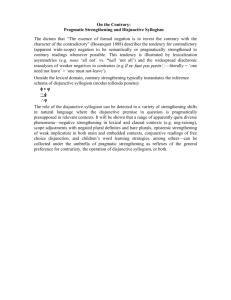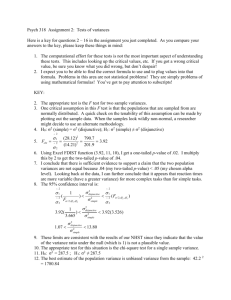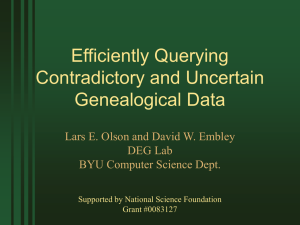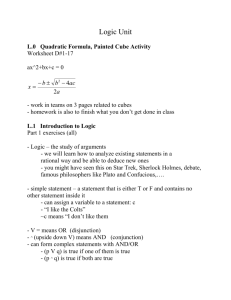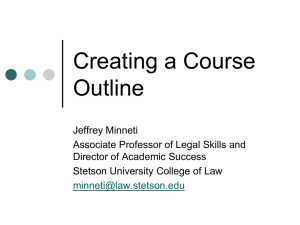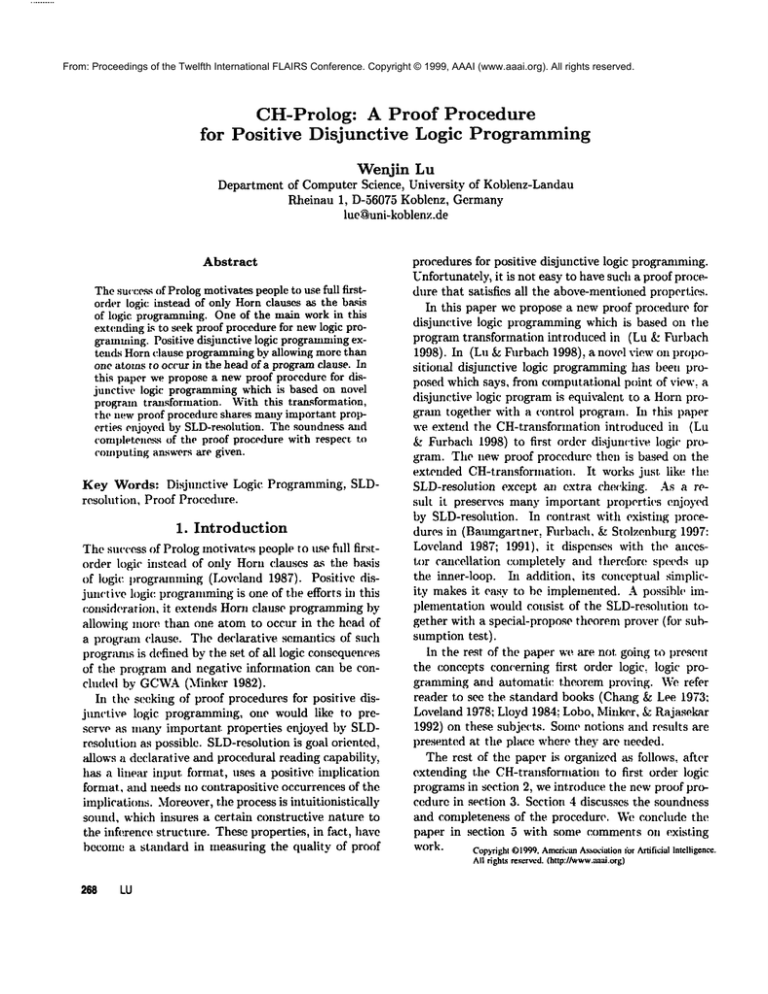
From: Proceedings of the Twelfth International FLAIRS Conference. Copyright © 1999, AAAI (www.aaai.org). All rights reserved.
CH-Prolog: A Proof Procedure
for Positive Disjunctive Logic Programming
Wenjin
Lu
Department of ComputerScience, University of Koblenz-Landau
Rheinau 1, D-56075 Koblenz, Germany
lue~uni-koblenz.de
Abstract
Thesuc’ce.~of Prologmotivat~peopleto use full firstorderlogic: instead of only Hornclauses as the b~is
of logic programming.
Oneof the main workin this
extendingis to seek proof procedurefor newlogic progrannning.Positive disjunctive logic programming
extends Hornclause progrvanming
by allowing morethan
one atomsre occurin the heado/’a program
clause. In
this paperwe proposea newproof procedurefor disjunctive logic programming
which is based on novel
program transformation. With this transformation,
the new proof procedure shares manyimportant properties enjoyed by SLD-resohltion. The soundness and
completeness of the proof procedure with respect to
computinganswersare given.
Key Words: Disjunctive
Logic Programming, SLDresolution, Proof Procedure.
1. Introduction
The suc(.ess of Prolog motivates people to use full firstorder logic instead of only Horn clauses as the b&~is
of logic programming (Loveland 1987). Positive disjunct ire legit: i)rogrammingis one of the efforts in this
consideration, it extends Horn clause progrmnmingt~v
allowing more than tree atom to occur in the head of
a program clause. The declarative semazltics of such
programsis defined by the set of all logic consequences
of the program and negative information can be conchuled by GCWA
(Minker 1982).
In the seeking of proof procedures for positive disjure’tire logic programming, one would like to preserve as many important properties enjoyed by SLDresolution as possible. SLD-resolution is goal oriented,
¯ allows a declarative azld procedural reading capability,
has a linear input format, uses a positive implication
fornmt, and needs no contrapositive occurrences of the
implications. Moreover,the process is intuitionistically
sound, which insures a certain constructive nature to
the infe.rem’e structure. These properties, in fact, have
become a standard in measuring the quality of proof
268
LU
procedures for positive disjunctive logic progranlming.
Unfortunately, it is not easy to have such a proof pn)cedure that satisfies all the above-mentionedproperties.
In this paper we propose a new proof procedure for
disjunctive logic programming which is based on the
program transformation introduced in (Lu & Furbach
1998). In (Lu & Furbach 1998), a novel view on prot)ositional disjunctive logic programminghas been proposed which says, from computational point of view, a
disjunctive logic programis equivalent to a tiorn program together with a control program. In this paper
we extend the CH-transformation introduced in (Lu
Furbach 1998) to first order disjunctive k)gic program. The new proof procedure then is based on the
extended CH-transformation. It works just like the
SLD-resolution except an extra checking. As a result it preserves manyimportant prot)erti(,s enjoyed
by SLD-resolution. In contrast with existing l)rocedures in (Bmungartner, Furbach, & Stoizenburg 1997:
Lovcland 1987; 1991), it dispenses with the ancestt)r cancellation completely and dmr(,ft)r(~ speeds
the inner-loop. In addition, its conceptual simplicity makes it easy to he implemented. A possiblr implementation woukl consist of the SLD-resolution together with a special-proi)ose theorem prover (for subsumption test).
In the rest of the paper we are not going to present
the concepts concerning first order logic~ logic programming and automatit: theorem proving. We refer
reader to see the standard books (Chang & Lee 1973;
Loveland 1978; Lloyd 1984; Lobo, Minker, & Rajasekar
1992) on these subjects. Somenotions and results are
presente.d at the place where they are needed.
The rest of the paper is organized as follows, after
extending the CH-transformation to first order logic
progrmns in section 2, we introduce the new proof procedure in section 3. Section 4 discusses the soundness
and completeness of the procedure. Weconclude the
paper in section 5 with some comments on existing
work.
Cop)right
©1999.
American
Association
forArtificialIntelligence.
Allrightsreserved.
(http:/Avww.aaai.org)
2. CH-Transformation
This section extends the CH-transformation of propositional disjunctive programs introduced in (Lu & Furbach 1998) and its properties to first order case.
The following theorem and its corollary are very important for developing a proof procedure for disjunctive programs in the next section. Its proof can be
found in (Lu 1998).
Definition 1 (CH-transformation) Let P be a disjunctive program. For each clause C 6 P of the form
Theorem 2 Let P be a disjunctive
program and
CH(P) = PH + Pc be the CH-transformation of
Then for any formula ~ which contains no control
atoms, we have P ~ a iff CH(P) ~
al V ... Van~-- bl,...,bm
the CH-transformation of C, denoted by CH(C), is
set of clauses defined by:
Corollary 3 (Model Preservation)
Let P be a disjunctive program and CH(P) = PH + Pc is the CHtransformation of P. Then M is a model of P iff there
is a model Mc of Pc such that M U Mc is a model of
CH(P).
{c}:.= 1,
CH(C
!
Cch n > 1,
where Cch is the set of the following clauses:
Ax(Vc) V... V A,(Vc)
al ~’- bl,. . . , bfa, A, (Vc)
a, ~ bs,...
,bm,An(Vc)
and A1, ..., An are new predicates not occurring in
P, which are referred as control predicates, Vc is the
tuple of all variables appearing in C. The atoms formed
by control predicates are called control atoms and the
clause
A(Vc)v A2(Vc)
V... v a.(vc)
(X)
is called a control clause. The CH-transformation of
P, denoted by CH(P), is defined by
C~(P) = [.] CH(C).
cGP
By thedefinition,
a clause
in CH(P)is either
a Horn
clause or of the form (1) (control clause). Therefore
CH(P) can be written as follows:
CH(P) = PH +
where Pc’ is the program consisting of all control
clauses in CH(P) and PH is the Horn program consisting of all Horn clauses in CH(P). Pc is called the
control program. The following facts are trivial.
¯ The control clauses in Pc consist of only control
atoms. No control atom occurs more than once in
3. CH-Prolog
In this section we provide the proof procedure CHProlog for disjunctive logic programs. The prefix "CH"
on the one hand hints that the procedure is based on
the CH-transformation and on the other indicates that
CH-Prolog is a Prolog with a "CHecking".
Prolog deals with Horn programs. The basic proof
procedure for Prolog is the SLD-resolution which uses
SLDderivation as an inference mechanism. An SLDtree for a Horn program P and a goal G is a tree in
which each branch is a SLDderivation of P U {G}. A
branch corresponding to a successful deri,~tion (ending with goal [3) is called a success branch, a branch
corresponding to an infinite derivation is called an infinite branch and a branch corresponding to a failed
derivation is called a failure
branch.
It has been proved that SLD-resolution is sound and
complete wrt. Horn programs. Roughly speaking, P u
{G}is unsatisfiable iff there is a success branch in an
SLD-tree for P with goal G.
Given a disjunctive program P, let CH(P) = PH
Pc’ be the CH-transformation of P. Recall that PH
is a Horn program and Pc is a set of disjunctive facts
consisting of only control atoms (formed by new predicates not appearing in P). Each clause in PHcontains
at most one control atom and control atoms never occur in the head of any Horn clause in the Horn program
PH. Then the new proof procedure is motivated by the
following obser,ation. Given a goal ~ Q, assume that
P U {-~Q}is unsatisfiable. Then either
¯ Each Horn clause in P/t contains at most one control
atom. No control atom occurs twice in PH.
¯ PHU{-,Q}is unsatisfiable, in this case, by completeness and soundness of SLD-resolution, there must be
a successful branch in the SLD-tree of PH and goal
or- Q: or
¯ Each control atom occurs exactly twice in CH(P):
once in Pc and once in PH- It forms a one-to-one
mapping.
¯ there must be a failure branch ending with a subgoal
consisting of only control atoms. Let +- C1,..., +-C, be all the leaf nodes such that Ci (1 < i <
Pc.
LOGICPROGRAMMING 2~
n) is a conjunction of only control atoms, then
{V(-~CI) A... AV(-~Cn)}Pc: must be unsatisfiable,
that is, 3(Ca V ... V Cn) is a logic consequence
Pc.. Note that Ct V ... V Cn is a disjunctive normal formula (DNF) and Pc can be understood as
a conjunctive normal formula (CNF), filrthermore,
they both contain no negative literals, therefore, after converting C1V... vCn into a conjunctive normal
formula, its unsatisfiability can be checked by subsumption.
With this observation a rmwcalculus is introduced by
simulating SLD-tr~ building for PH and ~ Q. To
introduce the proof procedure formally, we need some
notions.
Definition
4 (Restricted
SLD-tree) Let P be a
disjunctive program and CH(P) = PH + Pc be the CHtransformation of P. Let G be a goal. Assume R to be
a computation rule that only selexts non control atoms.
A r’estricted SLD-tree for P U {G}is the SLD-tree for
PHand goal G via R. A restricted success brunch in a
restrqcted SLD-tree is the branch ending either with an
empty clause [] or with a goal consisting of only control
atoms.
By the above observation, only the ending subgoals
of the restricted successfid branches need to be kept for
checking. Therefore in a CH-Prolog deduction, each
line t.ypically has the form
G#CI#... #C.,
where G is the current selected goal in an SLD-tree
and Ci’s are conjunction of (:ontrol atoms in the ending subgoal of the restricted successful branches. No
variables are shared amongG, C1,..., C,.
As in nIl-Proiog, a CH-Prolog derivation is composed of blocks, each block basically simulates a branch
in SLD-tr,’(’.
Definition 5 (SLDCH-derivation) Let P be a disjunctive program and CH(P) = PH + Pcr. Let G
a goal. Assume R to be a computation rule that only
selects non control atoms. An SLDCH-derivation is a
sequenceLo, Ll .... , Ln . ¯., where
1. Lo is the given goal G and
2. If Li = Gi#CI#...#Ck
and Gi contains a non
control atom, then Li+ l --- G i-r l #CI #... ~CkG i+ l
is derived from Gi and a variant of some clause
Ci+t E Ptt using a most general unifier 0 via R.
3.
If
Li --
Gi#Ct#...
control atoms, then
270
LU
#Ck and Gi
consists
of only
Checking: if there exists a substitution 0 such that
(C1Y...YCtcVCk+l)0 is a logic consequence o/Pc,
where. Gi =e- Ck+l, then Li+l = 1"7. Otheraoise
Restart: Li+l = G#CI#... #C~#Ck+I.
A block is a subsequence that begins with a restart
(start) line and ends before the next restart line (i/
any). An SLDCH-derivation is called an SLDCHre, ration if it contains a empty clause D.
Although an SLDCH-derivationis defined in a similar way as near-Horn Prolog, the differences are apparent. In an nH-Prologderi~,-ation a typical line has the
following form:
G#a[D],
where G is a subgoal, a is an atom called active head,
[D] denotes a list of deferred heads. Whena program
clmlse C of the form
al V ...Vain
e-
bl ..... bn
is called because one of the atoms in the head, say a,,
unifies with the calling goal in G, the calling head goal
is replaced by the body bl,...,bn (suitably instantiated) as for Prolog, but also the remaining head atoms
{al .... , a~- i , ai+ l .... , am} are enteredleftmostin the
deferred head list. Variables may be shared amongthe
G, the active head and tim deferred head list, and thus
instantiation of a variable in one portion of line mayaffect other elements in the line. In addition, nH-Prolog
needs cmacellation operation: that is, if the calling goal
unifies with an active head, the calling goal is cancelled.
CH-Prolog differs from the near-Horn Prolog mainly
in the following two aspects:
1. no variable is stlared
amongG and Ci’s in a line
G#Cl#... #C,,,
2. ancestor cancellation is completely avoided.
Roughly speaking, except the checking rule, SLDCHderivation works exactly same as SLD-derivation.
Therefore in CH-Prolog, high inner-loop speed can be
expected.
Example 6 (SLDCH-refutation) This example is
taken,h’om (Lovehnd 1991), there it is used to demonstrate that the Naive nH-Prologis not complete, that is,
q is a logic consequencebut it does not exists a Naive
nH-Prologrefutation for P t.J {-~q}.
P:
q+--a,b
a ¢c--c
ae-d
cVd
be- e
be-I
eVf
G:
e-q
then the CH-transformation of P is as follows.
CH(P) = PH + Pc
where
PH:
q~a,b
Pc:
a +--c
CxVC2
C3VC4
(1 < i < rn) with renaming substitution Pi. Let 0~
(1 < i < rn) be the composition of substitutions computed in Bi, and substitution a be a most general substitution such that Cxcr V ... V Cmais a logic consequence of Pc.. Let ai (1 < i < m) be the substitution
obtained by restricting tr to the variables in piOi. Then
an SLDCH-computedanswer is given as
a6-d
QplOaOl v...
c~ C1
d~-C2
b~e
b6-f
e~C3
Example 9 (Computed Answer) Let P be the following program:
P:
f ~-C4
The following is an SLDCH-refutation of P U {G}.
start:
+--q
e- a,b
#- c,b
restart:
q#C1,C3#C1,C4
6- a, b#Cl, C3#C,:
6"4
d, b#Cl , C3#C1, C4
C2, b#C1, C3#C1, C4
+- Cl,b
4-" C1:~
*- C1,C:~
v QPrnOm~ra.
6- C2,e#C,,C.~#C1,
C4
~- C2:C3#Ct,C3#C,,C~
P(a, y) ~ R(a,
P(z, b) +- S(z,
a:
~- P(x, y)
R(z,y) vS(z, y)
where G is a goal. The CH-transformation
PIt + Pc of P is as follows:
CH(P)
Ptt : P(a, y) ~- R(a,
P(x, b) +-- S(z,
R(x,y) Cl
(x,y)
S(z,y)~ C2(x,
The following is an SLDOH-refutation of P U {G}:
restart:
+-- q#Cj, C:~
*-- a, b#Cl, C:~
e- c, b#Ct . C3
C1, b#Cl, Ca
~- C,, $#C,. C3
C,,C~#Cl, Cs
restart:
a#C~, c3#cl, c~#c2,c3
+- a, b#Ca, C.a#C, , C4#C2,C3
+- d,
b#Cl,
C3#Cl ,
C4#C2, C3
,- C.~,b#Cl, C3#Cl
, C4#C._,,C,~
4"-
C2,f#01,C8#Cl..C4#C2:C3
C.,., C4#C~, C~#C~
, C4#C.2,Cs
[]
4. Soundness and Completeness
In this section we discuss soundness and completehess of CH-Prolog. Since CH-Prolog is developed as
an interpreter for disjunctive programs, as argued in
(Bauxngaxtner, Furbach, & Stohenburg 1997), it
more desirable to have soundness and completeness
with respect to answers. Therefore we first begin with
the definition of a correct answer and computed answer.
Definition
7 (Answers, Correct Answer) Let P
be a disjunctive program. If +-- Q is a query, and
Oh,...,O,, are substitutions for the variables from Q,
then QOt v ... v QOmis an answer. An answer QOxv
...VQOm is a correct answer if P ~ V(Q01v...VQOm).
Definition 8 (Computed Answer) Let P be a disjunctive
program and CH(P) P~t + Pc. Let
~- Q be a goal and used as the top clause in an
SLDCH-refutation. Let the refutation contain m blocks
B1 .....
Bm and Bi (1 < i <_ m) end with the subgoal ~ C~. Assume that +-- Q is called in each Bi
(1) ¢- P(x,y)
(2) ,e- S(z,b)
(3) +- C.,(x, b)
(4) e- P(u,v)#C2(x,b)
(5) ~ R(a,v)#C2(x,b)
(6) +- Cl(a,v)#C2(z,b)
(7) []
{y +- b}
{restart}
{u +-{x ~ a,v ~ b}{cheeking}
This refutation has two blocks B1 and B2. B1 consists
of the first three lines, andB.2 consists of the lines (4),
(5), (6), in which line (4) is a restart line with
+-- P(z, It)p, where p = {z ~ u, It +’- v} is a renaming
substitution. Line (7) is a checking. The substitution
computedin B1 is 01 = {y +-- b}, and the substitution
computed in B2 is 02 = {u 4-- a}. The substitution
computedin the checking step is tr = {x +-- a.. v ~ b}.
Therefore, the computed answer is
P(z, It)01 aa V P(x, It)pO.2tr2 =P(a,
where trl = {x ~ a} and tr.2 = {v *-- b} are the substitutions obtained bIt restricting tr to the variables in 01
and pO2,respectivelit.
The following
theorem shows that the SLDCHcomputed answers are correct answers.
Theorem 10 (Soundness) Let P be a disjunctive
programand let ~ Q, be a goal. If there is an SLDCHrefutation with computedanswerQ~ll V... V Q, Orn, then
P ~ v(qmv... v q,~,,,).
LOGICPROGRAMMING
271
Proof: See (Lu 1998).
Next we turn to the completeness of CH-prolog.
As uotcd iu (Baumgartner, Furbach, & Stolzenburg
1997), the mlswer completeuess theorem stated in the
following way has a very subtle difference from the result presented in (Lobe, Minker, & Rajas¯ "kar 1992).
Ttle approach of (Lobe, Minker, & Rajasekar 1992)
can not handle the case correctly if there are variable
interdependencies in disjunctive answers.
Theorem 11 (Answer-Completeness
of SLDCH)
Let P be a disjunctive program, +-- Q be a query and
QOl v ... v QOt be a correct answer for P. Then
there exists an SLDCH-refutation with computed answerQal y. . . v Qa,, such that Qaxy. . . v Qa,,~ entails
QOtv ... v QOi,i.e...
3~vi ¯ {1,...,m} 3j ¯ 11 ..... l} Q~= Ooj .
P~vo~ See (Lu 1998).
5. Conclusions
In this paper we present a new proof procedure for disjunctive logic progrmnming. Compared with existiug
proof t)rocedures, the t)roposed CH-Proh)gshares more
important prol)erties enjoyed by Prolog. Its conceptual
simplicity makes it easy to be imph~nmnted.
Several proof i)rocedures for disjunctive logic programminghave I)een proposed in literature. In (Lobe,
Minker, & Rajasekar 1992), SLI-resolution is used
,as a (’ah:ulus fi)r positive disjunctive logic programming, but it completely ignores the consideration on
the contrapositives.
Being aware of this deficiency
of SLI, (Baumgartner, Furbach, & Stolzenburg 1997)
developed a l)roof procedure for positive disjunctive
logic programrning based on model elimination (Lovehmd 1968). In (Baumgartner, Furb,’u’h. & Stolzenburg 1997), a family of restart variants of model
elimination and a mechanism for computing answers
were introduced. As indicated in (Loveland & Reed
1992), model elimination does have two main disadvm~tages, first, the operation of ancestor cancellation
implies a sacrifice in inner-loop speed. As the deptt~
of refutation increases, the number of ancestor goals
which must be checked for cancellation incre,’L~es proportionally. Second, the use of contrapositives destroys the procedural reading of clauses. Restart model
elimination may be s~n as addressing the second
disadvantage of model elimination by employing the
restart operation. Near-Horn Prolog (Loveland 1987;
1991) seems to be an attractive proof procedure for
positive disjunctive logic programming,it shares many
properties with SLD-resolution, except that the linearity and the procedure reading properties are local only.
The degree of locality depends on the number of uses
272
LU
of non-Horn clauses in the computation. However, ,as a
memberof the ancestry family of procedures (Lovt’land
& Reed 1992), the disadvantage of ancestor cancellation is not completely addressed, that is, azmestor cancellation operation still remains (in a limited form)
near-Horn Prolog. The main difference between CHProlog and Near-Horn Prolog is that while the former doing checking (subsumption) in the last step of
derivation, the later does it (for ancestor cancellation)
in every step of a derivation. Therefore, CH-Prolog
share higher inner-loop speed than Near-Horn Prolog.
Mazly interesting topics remain to be done. Next we
arc going to present a real implementation and coinparing it with existing procedures.
References
Baumgartner, P.: Furbach, U.: and Stolzenburg, F.
1997. Computing Answers with Model Elimination.
Artificial Intelligence 90(1 2):135-176.
Chang, C., and Lee, R. 1973. Symbolic Logic and
Mechanical Theov~mP~vving. Acaxtemic Press.
Lloyd, J. 1984. Foundations of Logic P~vgramming.
Springer.
Lobe, J.; Minker, J.; aald Rajasekar, A. 1992. Foundations of Disjunctive Logic P~v.q~umntiug.MI’F-Press.
Loveland, D. W., and Reed, D. W. 1992. Near-Horn
Prolog and the Ancestry Family of Procedures. Technical Report CS-1992-2(l. Department of Computer
Science, Duke University, Durtlam. Norlh Carolina.
Loveland, D. 1968. Mechanical Theorem Proving by
Model Elimination..IA CM15(2).
Loveland, D. 1978. Automated Theorem Proving - A
Logical Basis. North Holland.
Lovel~md, D. 1987. Near-Horn Prolog. In I.assez.
J.-L., ed., Prvc. of the 4th Int. Conf. on Logic Prog~wmming, 456 469. The MIT Press.
Loveland. D. 1991. Near-Horn Prolog an(t Beyond.
Journal of Automated Reasoning 7:1--26.
Lu, W., and Furbach, U. 1998. Disjucrive logic program = Horn program + Control program. In Proceedings of JELIA "98, number 1489 in Lecture Notes
in Artificial Intelligence, 33 46. Springer-Verlag.
Lu, W. 1998. Nonmonotonic Reasoning based on
Minimal ModeLsand Its Implementation. Ph.D. diss..
Dept. of Computer Science, Uinversity of KoblenzLandau.
Minker, J. 1982. On indefinite databases and the
closed world assumt)tion. In Proceedings of the 6th
Conference on Automated Deduction, New York, 292-308. Berlin: Springer.

